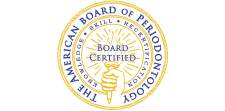Regenerative Dentistry
Understanding Dental Bone Loss in Detail
The jaw’ bone volume can be lost with periodontal disease, tooth loss, pressure from dentures or partial dentures, trauma, injury, or atrophy. The result is unsightly deformities or depressions in the bone, which can produce an unattractive restoration, a cleansibility problem, or an inability to place dental implants.
Hard and soft tissue reconstruction — to build back lost structure — can be effective procedures to either prevent volume loss, remedy it, or provide soft tissue coverage, thereby improve appearance, and allow dental implant placement or both.
The most common causes of dental bone and gum loss:
- Periodontal Disease: “Gum disease” involves infection and subsequent inflammation of the gums, It can spread to the attachment supporting the teeth. Progression of periodontal disease can lead to tooth and bone loss, as the infected attachment and bone deteriorates.
- Tooth Loss: When a tooth is lost, the bone that once supported it no longer receives the necessary stimulation and begins to shrink, leading to volume loss.
- Pressure from Dentures or Partial Dentures: Dentures or partial dentures can exert uneven or excessive pressure on the jawbone, accelerating bone loss when neither tooth rots or implants are present.
- Trauma or Injury: Physical impacts can lead to either immediate bone loss or gradual loss over time.
- Atrophy: Natural aging can result in bone density reduction and volume loss.
Bone loss can result in unsightly deformities or jaw indentations, affecting aesthetics and functionality. Bone loss can hinder cleansability, produce unattractive restorations, and even prevent the placement of dental implants.
Hard and Soft Tissue Reconstruction and Regeneration
To build back lost structure and address these issues, Dr. Newhouse specializes in hard and soft tissue reconstruction and regeneration. Such procedures can be effective in preventing volume loss or remedying it. Appearance and functionality can then be improved and make dental implant placement a possibility.
Bone Regeneration
With periodontitis, the teeth can lose their supporting bone, leading to tooth mobility, changes in chewing and speech function, and even tooth loss. Dr. Newhouse, leveraging her extensive experience and the latest clinical research, uses autografts (patient’s own bone), allografts (processed banked materials), xenographs (processed materials) or a combination of them combined with biologics (proteins that speed healing) and membranes to isolate and hold graft in place to reconstruct the lost jaw structure. This treatment can tighten teeth and reestablish function, but also helps save teeth and maintain the natural attractiveness of your smile.
Regeneration of Tooth Root Coverage
Healthy gums form a protective and aesthetic “picture frame” for the teeth. When gums recede and roots are exposed, teeth appear long, may have increased sensitivity to temperature and touch, and have increased susceptibility to decay.. Dr. Newhouse’s advanced gum grafting techniques recover exposed roots, rebuild lost gum tissue and attachment, can decrease sensitivity, and reduce decay susceptibility. The result is a rejuvenated, aesthetically pleasing smile.
Tooth Socket Regeneration and Preservation
In cases where teeth cannot be saved due to problems such as fractures or root canal failures, Dr. Newhouse performs socket regeneration immediately following tooth extraction. This process is crucial to preserve the bone’s dimensions, preventing up to 30% of bone loss in all directions. This preservation is vital for future implant placement, aesthetic tooth replacement, and adjacent teeth support. Ultimately, this forms the foundation for a healthy, pretty smile.
Hard and Soft Tissue Reconstruction
Procedure Steps:
- Initial Assessment: Dr. Newhouse evaluates the patient's oral health, determining the extent of tissue loss.
- Anesthesia: Local anesthesia is administered for comfort.
- Tissue Harvesting (if needed): Soft tissue is harvested from the patient's mouth or a donor source.
- Reconstruction: The harvested tissue is placed in the targeted area. For hard tissue, grafting materials are used to rebuild bone structure.
- Suturing: The area is sutured to secure the graft in place.
Duration:
- The procedure typically takes 1-2 hours, depending on complexity.
Recovery Process:
- Mild discomfort and swelling are common for a few days.
- Complete healing may take several weeks to a few months.
Post-Procedure Care:
- Avoid strenuous activity for a few days.
- Follow a soft diet and maintain oral hygiene as instructed.
- Attend follow-up appointments for monitoring and removal of sutures.
Bone Regeneration
Procedure Steps:
- Assessment: Comprehensive evaluation of bone loss.
- Anesthesia: Application of local anesthesia.
- Grafting Material Placement: Insertion of bone graft material, either from the patient's body, a donor, or synthetic.
- Membrane Placement: Application of a resorbable membrane to protect the area and encourage regeneration.
- Closure:Suturing the gum tissue over the graft.
Duration:
- Typically 1-2 hours.
Recovery Process:
- Expect some swelling and discomfort initially.
- Healing takes several months, during which the bone integrates with the graft material.
Post-Procedure Care:
- Soft diet and gentle oral care.
- Avoid smoking and alcohol.
- Regular follow-up visits for monitoring.
Root Coverage
Procedure Steps:
- Evaluation: Determining the extent of gum recession.
- Anesthesia: Local anesthesia for comfort.
- Graft Preparation: If necessary, harvesting gum tissue from the palate.
- Graft Placement: Positioning the graft over exposed roots.
- Suturing: Securing the graft in place.
Duration:
- About 1-2 hours.
Recovery Process:
- Some discomfort and swelling.
- Complete healing in a few weeks.
Post-Procedure Care:
- Soft diet.
- Avoid brushing the treated area initially.
- Regular dental check-ups.
Socket Regeneration
Procedure Steps:
- Tooth Extraction: Removal of the affected tooth.
- Socket Cleaning: Ensuring the socket is free of debris.
- Graft Placement: Inserting bone graft material into the socket.
- Membrane Application: Covering with a protective membrane.
- Closure: Suturing the site.
Duration:
- Usually about 30-60 minutes.
Recovery Process:
- Mild to moderate discomfort post-procedure.
- Healing takes a few months for bone integration.
Post-Procedure Care:
- Avoid disturbing the site.
- Soft diet for a few days.
- Regular follow-up appointments.
FAQ Section
Q: Is socket regeneration painful? What can one expect during recovery?
A:The procedure is performed under at least local anesthesia so patients are comfortable. Post-procedure, mild to moderate discomfort is typical. Usually discomfort is managed with ibuprofen or ibuprofen plus acetaminophen (Tylenol). Recovery is usually quick, and detailed aftercare instructions are provided to ensure a smooth healing process.
Q: How long does it take before implants can be considered after socket regeneration?
A: The healing time varies from patient to patient, but generally, it takes about 4-6 months for the bone to be mature enough for implant placement. Close monitoring of healing is done to determine the optimal time for the next steps.
Q: Are there any risks associated with root coverage procedures?
A: Like any surgical procedure, root coverage has some risks, such as infection bruising, swelling, or failure to get root coverage to name a few. However, these are rare or preventable for the most part. Every precaution is taken to minimize them. Each patient is made aware of the pros and cons of a procedure and every question or concern is discussed prior to scheduling to do anything.
Q: Will the smile look natural after root coverage?
A: The goal is to not only to cover the roots, thicken the “gums”, but also to enhance the attractiveness of the “picture frame” and ultimately a person’s smile.
Q: How successful is bone regeneration? Are the results permanent?
A: Bone regeneration can be highly successful when patients carefully follow post-operative care instructions and maintain good oral hygiene. While the results can be long-lasting, it's important to address the underlying issues, like gum disease, to ensure lasting results.
Q: Can anyone undergo bone regeneration, or are there specific criteria?
A: Most healthy patients can be candidates for bone regeneration. However, a thorough evaluation, including medical history and current oral and periodontal health, is conducted to determine suitability. Certain health conditions may require special considerations.





